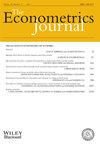关于多边分布变化程度的单位自由评估
IF 7
4区 经济学
Q1 ECONOMICS
引用次数: 3
摘要
社会科学中普遍存在对多个群体的结果进行多边比较的现象,对其可变性的测量,通常涉及各自群体位置和规模参数的函数,具有内在的意义。然而,这种方法往往掩盖了对相对群体分布结构进行更全面的研究所揭示的更根本的差异。事实上,在分类数据环境中,如果没有人为和可疑的类别基数化,基于位置和规模的技术就不再可行。在这里,Ginis的Transvariation测度被扩展并用于在离散、连续、分类、单变量或多变量环境中提供定量和可视化的多边比较工具,这在没有基数测度的范式中特别有用。两个应用程序,一个从组成国收入分配的趋同或分歧角度分析欧元区凝聚力,另一个来自对中国老龄化、健康和收入不平等的研究,证明了它们在连续和分类数据环境中的使用。多伦多大学经济系。剑桥大学经济学院。罗马萨皮恩扎大学统计科学系。首尔国立大学经济系。1.本文章由计算机程序翻译,如有差异,请以英文原文为准。
On unit free assessment of the extent of multilateral distributional variation
Multilateral comparison of outcomes drawn from multiple groups pervade the social sciences and measurement of their variability, usually involving functions of respective group location and scale parameters, is of intrinsic interest. However, such approaches frequently mask more fundamental differences that more comprehensive examination of relative group distributional structures reveal. Indeed, in categorical data contexts, location and scale based techniques are no longer feasible without artificial and questionable cardinalization of categories. Here, Ginis’ Transvariation measure is extended and employed in providing quantitative and visual multilateral comparison tools in discrete, continuous, categorical, univariate or multivariate settings which are particularly useful in paradigms where cardinal measure is absent. Two applications, one analyzing Eurozone cohesion in terms of the convergence or divergence of constituent nations income distributions, the other, drawn from a study of aging, health and income inequality in China, exemplify their use in a continuous and categorical data environment. Department of Economics, University of Toronto. Faculty of Economics, University of Cambridge. Department of Statistical Sciences, Sapienza University of Rome. Department of Economics, Seoul National University. 1
求助全文
通过发布文献求助,成功后即可免费获取论文全文。
去求助
来源期刊

Econometrics Journal
管理科学-数学跨学科应用
CiteScore
4.20
自引率
5.30%
发文量
25
审稿时长
>12 weeks
期刊介绍:
The Econometrics Journal was established in 1998 by the Royal Economic Society with the aim of creating a top international field journal for the publication of econometric research with a standard of intellectual rigour and academic standing similar to those of the pre-existing top field journals in econometrics. The Econometrics Journal is committed to publishing first-class papers in macro-, micro- and financial econometrics. It is a general journal for econometric research open to all areas of econometrics, whether applied, computational, methodological or theoretical contributions.
 求助内容:
求助内容: 应助结果提醒方式:
应助结果提醒方式:


